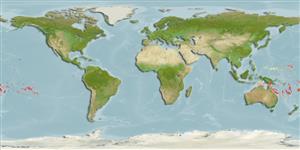>
Eupercaria/misc (Various families in series Eupercaria) >
Labridae (Wrasses) > Corinae
Etymology: Pseudojuloides: Greek, pseudes = false + Greek, iouis = a fish without identification, perhaps some of genus Coris cited by Plinius + Greek, oides = similar to (Ref. 45335); atavai: Name from Tahitian word 'atavai' meaning pretty, referring to the attractive coloration of both sexes of the species.
Eponymy: Not an eponym but from the Tahitian word for ‘pretty’. (Ref. 128868), visit book page.
More on authors: Randall & Randall.
Environment: milieu / climate zone / depth range / distribution range
ນິເວດວິທະຍາ
ສັດທະເລ ກ່ຽວກັນຫີນ; ລະດັບຄວາມເລິກ 12 - 31 m (Ref. 1602). Tropical; 14°N - 28°S
Pacific Ocean: Guam to the Society, Tuamoto, Austral and Ducie islands.
ຂະໜາດ / ນ້ຳໜັກ / Age
Maturity: Lm ? range ? - ? cm
Max length : 13.0 cm TL ຕົວຜູ້/ບໍ່ມີເພດ; (Ref. 9710)
ຄີ (ໜາມ)ແຂງຢູ່ຫຼັງປາ (ທັງໝົດ) : 9; ຄີຫຼັງຂອງປາ (ຄີອ່ອນ) (ທັງໝົດ) : 11; ຄີ(ໜາມ) ແຂງຢູ່ຄີກົ້ນປາ
ກຸ່ມປາກະດູກແຂງ
ຄວາມຖີ່ຂອງກຸ່ມຖ່າຍທອດພັນ
ປາທີ່ມີການເຄື່ອນຍ້າຍຈາກທະເລໄປຫານ້ຳຈືດ ແລະນ້ຳຈືດຫາທະເລ
ປາທີ່ມີການເຄື່ອນຍ້າຍຈາກທະເລແລະໄປໄຂ່ຢູ່ນ້ຳຈືດ
ຄີກົ້ນຂອງປາ
ສັດທີ່ມີກະດູກສັນຫັຼງ
ການຖ່າຍທອດທາງກຳມະພັນຈາກພໍ່ແມ່ຫາລູກ: 3; ຄີກົ້ນຂອງປາ: 12; ສັດທີ່ມີກະດູກສັນຫຼັງ: 25. This species is distinguished from its congeners by the following characters: body elongate with greatest body depth 22.6-25.3% SL; D IX,11; A III,12; pectoral-fin rays 13; tubed lateral-line scales 28. Colouration: interspinous membrane between anterior two to three spines of dorsal fin has a black spot; males with head yellow and extensively reticulate; abdominal region behind pelvic and pectoral fins is orange to orange-pink with yellow crosshatch markings; posterior part of body purple black; females are distinctly bicolored, orange-brown dorsally, white ventrally (Ref. 123182).
Found well above the bottom of exposed seaward reefs (Ref. 9710) away from lagoons and sheltered bays (Ref. 123182). Feeds on small invertebrates (Ref. 89972).
Life cycle and mating behavior
ການຈະເລີນເຕັມໄວ | ການສືບພັນ | ການວາງໄຂ່ | ໄຂ່ | ຄວາມດົກຂອງໄຂ່ປາ | ຕົວອ່ອນ
Oviparous, distinct pairing during breeding (Ref. 205).
Randall, J.E. and H.A. Randall, 1981. A revision of the labrid fish genus Pseudojuloides, with descriptions of five new species. Pac. Sci. 35(1):51-74. (Ref. 2140)
IUCN Red List Status (Ref. 130435: Version 2024-2)
Threat to humans
Harmless
Human uses
ເຄື່ອງມື
Special reports
Download XML
ແຫຼ່ງອີນເຕີເນັດ
Estimates based on models
Preferred temperature (Ref.
123201): 24.7 - 26.3, mean 26.1 °C (based on 12 cells).
Phylogenetic diversity index (Ref.
82804): PD
50 = 0.5000 [Uniqueness, from 0.5 = low to 2.0 = high].
Bayesian length-weight: a=0.00977 (0.00466 - 0.02049), b=3.07 (2.90 - 3.24), in cm total length, based on LWR estimates for this (Sub)family-body shape (Ref.
93245).
ຊັ້ນເຂດຮ້ອນ (Ref.
69278): 3.4 ±0.4 se; based on size and trophs of closest relatives
ຄວາມຢືດຢຸ່ນ (Ref.
120179): ສູງ, ປະຊາກອນຕຳ່ສຸດທີ່ໃຊ້ເວລາສອງໜ້ອຍກວ່າ 15 ເດືອນ (Preliminary K or Fecundity.).
Fishing Vulnerability (Ref.
59153): Low vulnerability (10 of 100).
Nutrients (Ref.
124155): Calcium = 95.7 [56.8, 165.3] mg/100g; Iron = 0.759 [0.442, 1.405] mg/100g; Protein = 18.5 [15.6, 20.7] %; Omega3 = 0.163 [0.103, 0.261] g/100g; Selenium = 23 [13, 42] μg/100g; VitaminA = 151 [47, 567] μg/100g; Zinc = 1.77 [1.20, 2.76] mg/100g (wet weight);
